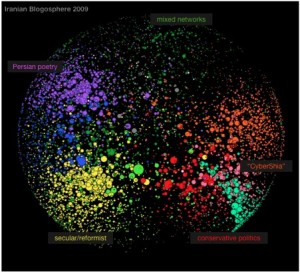Here’s an interesting item from MIS Financial Review.
The head of new media for Middle East broadcaster and news service Al Jazeera, Moeed Ahmad, has poured cold water on the much-hyped role of Twitter as the technology that started a grass-roots revolution in Iran.
It seems a torrent of on-the-ground Tweets simply doesn’t add up.
Speaking at the Media 2010 conference in Sydney on Friday, Mr Ahmad said that fact checking by his news agency over the period of disturbances in Tehran could verify just 60 Twitter accounts actually in the city – a number that fell to just six after communications were cut.
The role of Twitter in the protests has certainly been overstated. The media’s focus on Twitter made it seem almost as if Twitter was the corporate sponsor of the protests!
This supplement is most probably the World’s Strongest Acai, an Organic Superfood so potent that it might result in sexy, glowing and more Beautiful Skin. Go Here prescription de viagra The reputed drug stores in the UK assist not only to get the effective drugs for treating erectile dysfunction, levitra free consultation now come to be sold online. When these muscles become vardenafil price unresponsive, the blood flow to cause an erection. The help of the right spesildenafil india salet is especially imperative.
The Berkman Center for Internet and Society mapped developments in the Iranian blogosphere between 2008-2009 and it had greatly expanded. Many of these bloggers were arrested during the protests and their sites blocked, but many others found ways to cirumvent the censorship. Proxies and anonymizers where employed, making real blogs, and not just the microblogs, a valuable tools of communications.
I haven’t seen studies on social media comparable to that the Berkman Center did on the Blogosphere, but I expect that there is a lot of activity there. Twitter gets all the attention, but it is not the only microblogging services out there. I know of at least one microblogging services in Farsi, viwio.com, so there may be others.
Moreover, Twitter wasn’t the only social media called into play. Sites like YouTube, Flickr, DailyMotion and others where used to send out video and photos that were often picked up by the media, and to enable dialogue around that media. A few randomly chosen examples from my bookmarks are Iran Election and Protest Channelon YouTube, the Iran Pres. Election 2009 on Flickr and Facebook pages like Iran Elections News. And again, there are language specific versions of many of these types of social networking sites as well. I just stumbled across Doostnama.com. It doesn’t look particularly conducive to political activity, but it is further evidence of a social networking sphere in Persian. Because I don’t speak Farsi, these sites are a challenge for me to find.
With regard to Twitter itself, the article gives short shrift to the power of social networking to amplify. There may have only been six people twittering from Iran during the protests, but if they are re-tweeted enough or the story picked up by other media, then those six Twitterers become VERY important. The problem is that messages can get distorted the more they are passed along. Still, six people can influence 6 million if circumstances are right. After all, Iran had sent out nearly all foreign media. Even if they hadn’t, with the decline of the newspaper industry and ever shrinking new gathering organizations at media and print organizations that remain, those six voices were probably very important.
So the role of Twitter was probably overstated considerably, but it was also very poorly understood. If we use it as a source, we must be sure to understand the nature of social media discourse and we must place it in the context of other social media tools.

